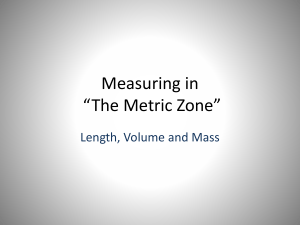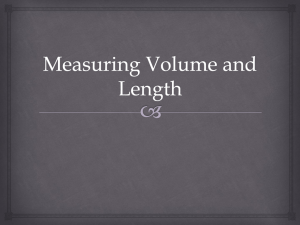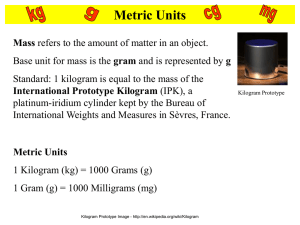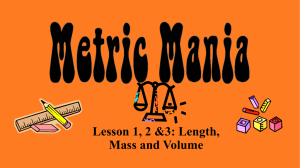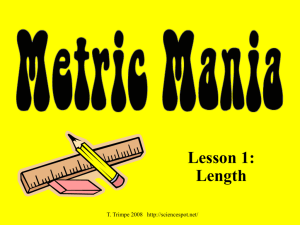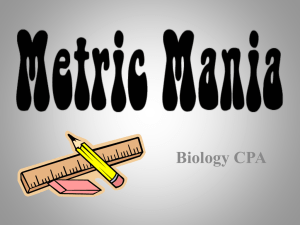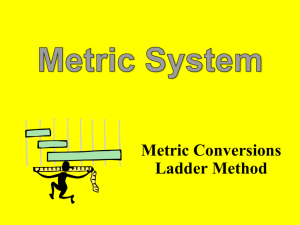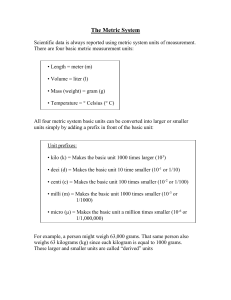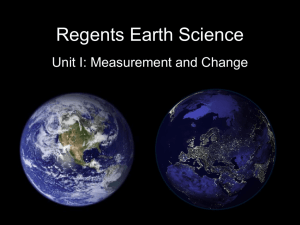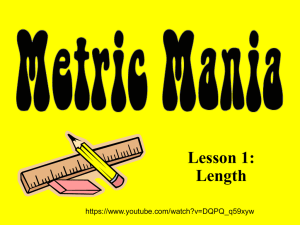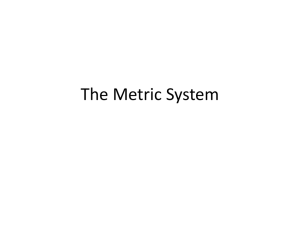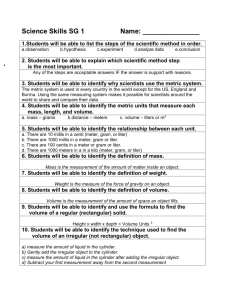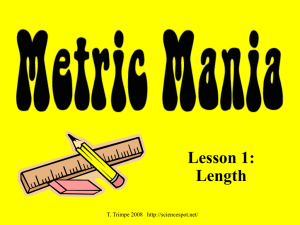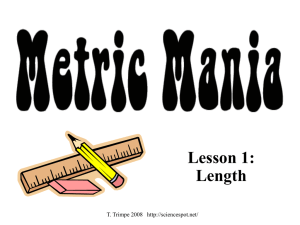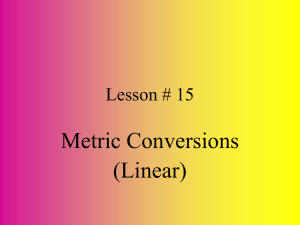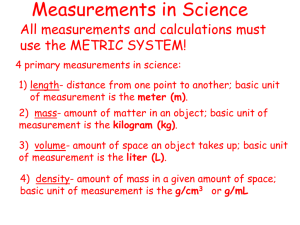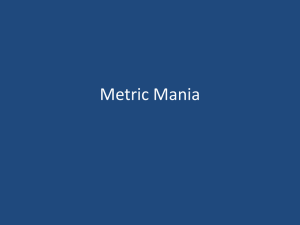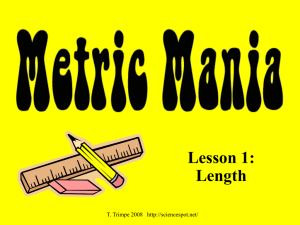File
advertisement
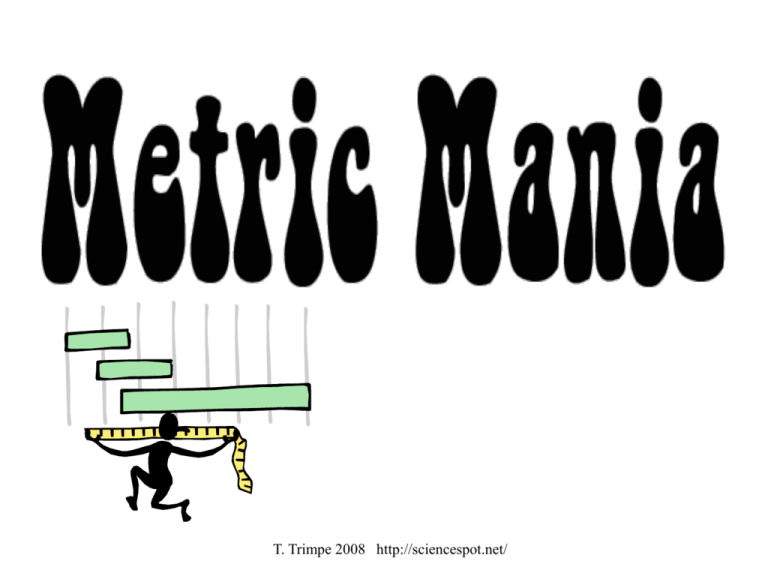
T. Trimpe 2008 http://sciencespot.net/ Metric Units The basic unit of length in the metric system in the meter and is represented by a lowercase m. Metric Units 1 Kilometer (km) = 1000 meters 1 Meter = 100 Centimeters (cm) 1 Meter = 1000 Millimeters (mm) 1 Meter = 1,000,000 Micrometers (μm) 1 Meter = 1,000,000,000 Nanometers (nm) Which is larger? A. 1 meter or 105 centimeters C. 12 centimeters or 102 millimeters B. 4 kilometers or 4400 meters D. 1200 millimeters or 1 meter Measuring Length How many millimeters are in 1 centimeter? 1 centimeter = 10 millimeters What is the length of the line in centimeters? _______cm What is the length of the line in millimeters? _______mm What is the length of the line to the nearest centimeter? ________cm HINT: Round to the nearest centimeter – no decimals. Ruler: http://www.k12math.com/math-concepts/measurement/ruler-cm.jpg Metric Units Mass refers to the amount of matter in an object. The base unit of mass in the metric system in the kilogram and is represented by kg. Standard: 1 kilogram is equal to the mass of the International Prototype Kilogram (IPK), a platinum-iridium cylinder kept by the BIPM at Sèvres, France. Kilogram Prototype Metric Units 1 Kilogram (km) = 1000 Grams (g) 1 Gram (g) = 1000 Milligrams (mg) Which is larger? A. 1 kilogram or 1500 grams C. 12 milligrams or 12 kilograms B. 1200 milligrams or 1 gram D. 4 kilograms or 4500 grams Kilogram Prototype Image - http://en.wikipedia.org/wiki/Kilogram Measuring Mass You can use a triple-beam balance to find the mass of various objects. The objects are placed on the scale and then you move the weights on the beams until you get the lines on the right-side of the scale to match up. Once you have balanced the scale, you add up the amounts on each beam to find the total mass. What would be the mass of the object measured in the picture? _______ + ______ + _______ = ________ g Top Image: http://www.southwestscales.com/Ohaus_Triple_Beam_750-SO.jpg Bottom Image: http://www.regentsprep.org/Regents/biology/units/laboratory/graphics/triplebeambalance.jpg Metric Units Volume is the amount of space an object takes up. The base unit of volume in the metric system in the liter and is represented by L or l. Standard: 1 liter is equal to one cubic decimeter Metric Units 1 liter (L) = 1000 milliliters (mL) 1 milliliter (mL) = 1 cm3 (or cc) = 1 gram* Which is larger? A. 1 liter or 1500 milliliters B. 200 milliliters or 1.2 liters C. 12 cm3 or 1.2 milliliters* * When referring to water Liter Image: http://www.dmturner.org/Teacher/Pictures/liter.gif Measuring Volume We will be using graduated cylinders to find the volume of liquids and other objects. Read the measurement based on the bottom of the meniscus or curve. When using a real cylinder, make sure you are eye-level with the level of the water. What is the volume of water in the cylinder? _____mL What causes the meniscus? A concave meniscus occurs when the molecules of the liquid attract those of the container. The glass attracts the water on the sides. Top Image: http://www.tea.state.tx.us/student.assessment/resources/online/2006/grade8/science/images/20graphicaa.gif Bottom Image: http://morrisonlabs.com/meniscus.htm Measuring Liquid Volume Images created at http://www.standards.dfes.gov.uk/primaryframework/downloads/SWF/measuring_cylinder.swf What is the volume of water in each cylinder? Pay attention to the scales for each cylinder. Ladder Method 1 2 KILO 1000 Units HECTO 100 Units 3 DEKA 10 Units DECI 0.1 Unit Meters Liters Grams How do you use the “ladder” method? 1st – Determine your starting point. 2nd – Count the “jumps” to your ending point. 3rd – Move the decimal the same number of jumps in the same direction. CENTI 0.01 Unit MILLI 0.001 Unit 4 km = _________ m Starting Point Ending Point How many jumps does it take? 4. __. __. __. = 4000 m 1 2 3 Conversion Practice Try these conversions using the ladder method. 1000 mg = _______ g 1 L = _______ mL 160 cm = _______ mm 14 km = _______ m 109 g = _______ kg 250 m = _______ km Compare using <, >, or =. 56 cm 6m 7g 698 mg Metric Conversion Challenge Write the correct abbreviation for each metric unit. 1) Kilogram _____ 4) Milliliter _____ 7) Kilometer _____ 2) Meter _____ 5) Millimeter _____ 8) Centimeter _____ 3) Gram _____ 6) Liter _____ 9) Milligram _____ Try these conversions, using the ladder method. 10) 2000 mg = _______ g 15) 5 L = _______ mL 20) 16 cm = _______ mm 11) 104 km = _______ m 16) 198 g = _______ kg 21) 2500 m = _______ km 12) 480 cm = _____ m 17) 75 mL = _____ L 22) 65 g = _____ mg 13) 5.6 kg = _____ g 18) 50 cm = _____ m 23) 6.3 cm = _____ mm 14) 8 mm = _____ cm 19) 5.6 m = _____ cm 24) 120 mg = _____ g Compare using <, >, or =. 25) 63 cm 26) 536 cm 6m 27) 5 g 53.6 dm 508 mg 28) 43 mg 29) 1,500 mL 5g 30) 3.6 m 1.5 L 36 cm
